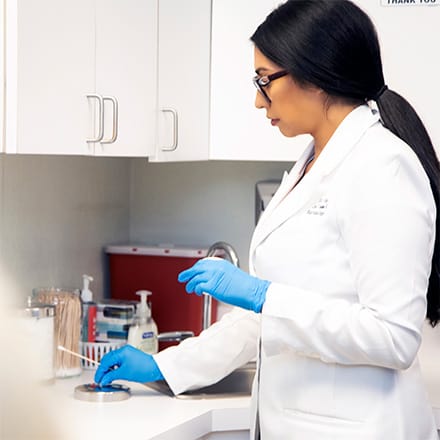Re-Operative Breast Surgery

Revisional Re-Operative Breast Surgery in Smithtown, Long Island
Breast augmentation is one of the most popular and successful plastic surgery procedures available today. However, as with all plastic surgery, breast augmentation does come with a degree of risk. In case of a rare complication, breast augmentation can create subpar results. In other cases, the surgery may have been successful but the patient is no longer happy with her implants because her preferences have changed.
Dr. Lloyd Landsman has a long history of successful plastic surgery results, including with breast augmentation. Known for his superb skill and dedication to safety, Dr. Landsman receives referrals for women who are unhappy with their breast augmentation results. Because no two patients are the same, Dr. Landsman handles breast revision cases with an individualized approach in order to deliver each patient’s desired outcome.
Re-Operative Implant Replacement Surgery (RIRS) in Suffolk County
Removing old saline or silicone gel implants and replacing them with state-of-the-art modern implants (a procedure known as “Re-Operative Implant Replacement Surgery,” or RIRS) requires careful assessment, planning and use of the full complement of materials and techniques available.
Who Is a Candidate for RIRS?
Women choose to undergo RIRS for different reasons including to:
- Change the size, shape or position of their breast implants
- Replace breast implants for another type
- Replace breast implants that have leaked or ruptured
- Address a complication such as capsular contracture, lateral displacement or bottoming out.
- Remove breast implants without replacing them
After 10 years, the rate of deflation for saline implants and the rate of rupture for silicone gel implants rises significantly. Also, there are many conditions that arise following long-term use of both types of implants that alter the appearance of the breast, including capsular contracture.
Capsular Contracture
Capsular contracture is the formation of unusually hard, thick scar tissue that contracts around a breast implant. This causes varying degrees of cosmetic deformity and pain.
Scientific literature shows that capsular contracture is more common in breast reconstruction cases as compared to cosmetic breast augmentation cases. However, the reasons why some women develop capsular contracture while others do not are not widely known. Radiation therapy (particularly following breast reconstruction surgery) is linked with a higher risk of capsular contracture. Implants placed in front of the chest muscle (as opposed to under it) are also slightly more likely to develop capsular contracture.
Preparing for Revisional Breast Reconstruction
Recognition, diagnosis and ultimately a precise operative plan to correct these alterations will result in outstanding outcomes.
Revisional Breast Reconstruction Assessment
Assessment includes:
- Are either or both the implants deflated or ruptured? Neither condition represents a health hazard and can therefore be addressed without haste.
- Are the breasts even in appearance? (asymmetry)
- Is there displacement of the breasts to the side? (lateral displacement)
- Are the implants sitting too low causing the nipple to sit too high? (bottoming out or lower pole stretch deformity)
- Is the nipple position low? (ptosis)
- Is there hardening of either breast from scar tissue around the implant? (capsular contracture)
- Do you want to be bigger or smaller?
- What type of implant would you prefer going forward?
- Do you no longer want implants?
Many of these conditions may exist simultaneously and in one or both breasts.
Following the assessment, a customized plan is put into place. Some of the above-mentioned conditions require additional materials and techniques. Capsular contracture and positional displacements require use of biological and biocompatible tissue sheets and special meshes in addition to new implants. Lifts (mastopexy), reduction of existing breast tissue and liposuction of the side wall adjacent to the breast are among the other techniques often used in this multiplatform approach.
Revisional Breast Reconstruction Surgery Details
RIRS is performed as an outpatient procedure, typically under general anesthesia. Your safety and satisfaction are top priorities to Dr. Landsman. Prior to your procedure, the doctor will go over your options for surgery and take your personal needs and preferences into consideration when creating your treatment plan. You are also encouraged to look at before and after photos of past patients to get a better visual of what results to expect.
Dr. Landsman can perform RIRS to replace the breast implants with another type. The doctor offers both saline and silicone gel implants and can replace one for the other. This type of procedure is relatively straightforward as Dr. Landsman will typically use the same incisions used for the original breast augmentation procedure to avoid additional scarring.
For women who desire larger breast implants, Dr. Landsman will enlarge the pockets in the natural tissue to accommodate larger implants. For smaller implants, the doctor will reduce the size of the breast pockets. Dr. Landsman can also remove breast implants altogether. If necessary, he may perform breast lift to remove skin that has been stretched out due to holding the implants and restore the breast to a perkier and youthful position on the chest wall.
In some instances, implants pockets can be created too far apart or too close together, creating an unnatural breast appearance. To correct this, Dr. Landsman can relocate the implant pockets to a more attractive and natural-looking position on the chest wall. This will often require the use of a tissue implant such as Galaflex to help maintain the new implants in their desired new position.
Dr. Landsman can also perform RIRS to correct capsular contracture, which occurs when the scar tissue around the breast implant, or capsule, hardens. In this case, the doctor will remove the implant and capsule, use a tissue insert like Galaflex to prevent recurrence of capsular contracture and replace the implants.
Preoperative Breast Implant Deflation or Removal
Another technique used to prepare for implant replacement is to deflate (saline) or remove (silicone) implants to allow the skin, breast tissue and the pocket where the implant is placed to shrink down prior to definitive surgery (usually for a minimum of two weeks). This may seem undesirable but significantly improves results.
RIRS is a complex undertaking which requires detailed planning and execution. No-cost touch up and revisional surgery is often necessary to achieve superior results.
Recovering from Revisional Breast Reconstruction Surgery
Recovery from RIRS is similar to the initial breast augmentation recovery. Patients should anticipate taking one to two weeks off from their normal routine, during which they will need to avoid vigorous activities including exercise. Dr. Landsman and his expert team will provide detailed instructions for your recovery during your consultation. Rest assured, the doctor and his team will also be available throughout your recovery to ensure your recovery is quick and successful.
Financing Options
Click here to learn more about financing your Breast Revision.
Learn More About RIRS
To find out more about revisional breast reconstruction, schedule a complimentary consultation with Dr. Landsman. Contact his office by calling (631) 864-4111 today.














